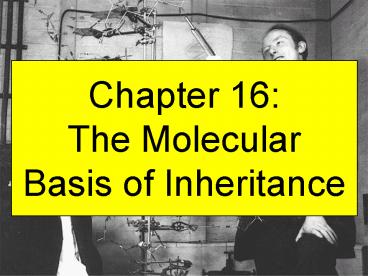Chapter 16: The Molecular Basis of Inheritance - PowerPoint PPT Presentation
1 / 35
Title:
Chapter 16: The Molecular Basis of Inheritance
Description:
... (1953) The Double Helix Base Pairing DNA Replication Hypotheses Meselson-Stahl Experiment ... Griffith s experiment, which is mediated by DNA) ... – PowerPoint PPT presentation
Number of Views:715
Avg rating:3.0/5.0
Title: Chapter 16: The Molecular Basis of Inheritance
1
Chapter 16The MolecularBasis of Inheritance
2
Important Point
If you are having trouble understanding lecture
material Try reading your text before
attending lectures. And take the time to read it
well!
3
The Hereditary Material
- Chromosomes consist of both DNA and Protein
- DNA was discovered before its role in heredity
was understood - People had a sense that chromosomes embodied
inheritance before they understood that DNA was
the hereditary material - People did not want to believe that DNA was the
hereditary material since it is not complex
enough - Instead, people believed that proteins must be
the hereditary materialthey were wrong - Transformation (I.e., Griffiths experiment,
which is mediated by DNA) was discovered before
it was understood that it was mediated by DNA
4
Transformation
Griffith, 1928
5
Transforming Principle Sensitivity to DNase
Hi, Im Oswald Avery. I figured out that the
transforming principle is DNA!
I did this by treating transforming principle
with different enzymes, proteases, RNases,
DNases only DNase destroyed its activity
Avery, MacLeod, McCarty (1944)
6
Avery, MacLeod, McCarty (1944)
Hi, Im Theodosius Dobzhanky. I wrote Genetics
and the Origin of Species (1937)
Hi, Im Colin M. MacLeod
Hi, Im Maclyn McCarty
Colin M. MacLeod, Maclyn McCarty, Detlev Wulf
Bronk, Theodosius Dobzhansky, and Wendell M.
Stanley
Hi, Im Detley Wulf Bronk. I asked, Are aliens
living among us (really)
Hi, Im Wendell M. Stanley. I crystalized (and
then X-rayed) tobacco mosaic virus!
7
Erwin Chargaff
I made an important observation on the chemistry
of DNA
8
Chargaffs Rule (1950)
9
Generalizing beyond Bacteria (sort of)
Hershey Chase, 1952
10
Hershey Chase (1952)
11
Maurice Wilkins (1950)
I took the first quality X-ray diffraction images
of DNA, and am credited with sparking the
interests of both Watson and Crick in the
question of DNAs structure
Rosalind Franklin worked under me
12
Better Pictures of DNA (1951)
13
Watson Crick (1953)
We figured it out
Now were famous!
14
The Double Helix
Strand complementarity
Strand polarity
Antiparallel strands
15
Base Pairing
16
DNA Replication Hypotheses
17
Meselson-Stahl Experiment (1957)
18
Semiconservative DNA Replication
19
Semiconservative DNA Replication
20
Origins of Replication
21
Nucleotide Incorporation
Pyrophosphate hydrolysis powers nucleotide
addition
22
Lagging Leading Strands
Both daughter strands are laid down in the 5 to
3 direction
100-2000 bases long, depending on species
23
Leading vs. Lagging Strands
24
Lagging-Strand Syn. (1/2)
Solves DNA polymerase requirement for 3 OH
25
Lagging-Strand Syn. (2/2)
26
Replication Fork Components
Yes, difficult to read, but it is in your text!
27
DNA Replication Enzymes
28
Replication Fork
Topoisomerase acts here
29
Proofreading
During DNA replication, DNA polymerases
proofread each nucleotide against its template as
soon as it is added to the growing strand. Upon
finding an incorrectly paired nucleotide, the
polyerase removes the nucleotide and then resumes
synthesis. (This action is similar to fixing a
typing error by using the delete key and then
entering the correct letter.) p. 305, Campbell
Reece (2005)
30
Excision Repair
31
The Problem of Ends
Erosion of ends
32
A Solution Telomeres
Telomere are sequences found on the ends of
Eukaryotic DNA that are added on by an enzyme
called telomerase
Telomeres erode so that genes dont have to!
33
Central Dogma Preview
34
Central Dogma Preview
35
The End































